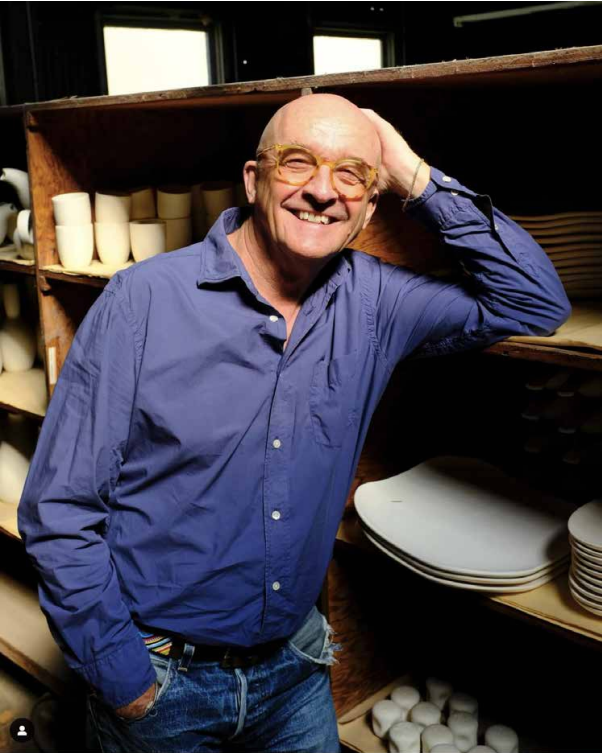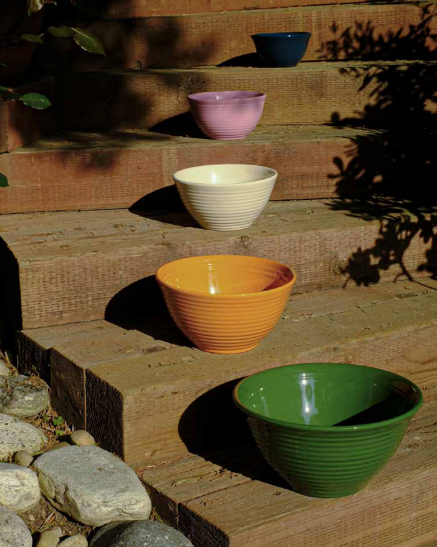Our Story
Decades after the original factory ceased production, Bauer Pottery continues to captivate antique collectors across the country. In 1998, current owner Janek Boniecki purchased the trademark rights to reproduce Bauer Pottery designs. Thus began the newest era of Bauer. Using existing vintage pieces to derive new molds, the company now manufactures replicas of original Bauer designs, in many original and new colors. Now manufactured without harmful elements like lead and uranium, 21st-century collectors can feel confident that while their Bauer 2000 pottery is glazed as brightly as the original line, it is completely food-safe.

Bauer History
In 1878, Andreas Bauer, later known as J. Andy or J.A. Bauer, started his life in the pottery business in Louisville, Kentucky at Preston Street Pottery, which was owned by his eldest brother John. By 1885, J. Andy struck out on his own, purchasing Paducah Pottery, in Paducah, KY.
The company gained success producing a variety of utilitarian pieces for direct sale and to other manufacturers and distillers, such as crocks, whiskey jugs, and oil jars. The company also produced standard redware pieces for the garden, like flowerpots, saucers, seed pans and hanging baskets.
In 1910, after having wintered in Southern California a few times, Bauer decided to seek relief from the Midwestern cold and move his family and business to Los Angeles permanently. The J.A. Bauer Pottery Company opened in Lincoln Heights, just north of downtown. Initially, they began producing many of the same items that had been made in Paducah, but they didn’t stop there. Bauer Pottery quickly added items more suited to their new surroundings. A wider variety of nursery and floral items joined the line, as well as western-styled pieces befitting the California bungalow aesthetic, such as the Indian bowl.
During the next decade, potters Louis Ipsen and Matt Carlton would join the company. Business expanded with floral and gardenwares continuing to drive much of the company’s production. As the company grew, so too did J.A. Bauer’s personal fortune. He owned multiple properties in Pasadena and a ranch in Norwalk. He was active in his church and other community organizations. In 1922, he retired, selling two-thirds of the company to investors from the Bernheim family of Louisville and the other third to his daughter Eva and son-in-law Watson Bockman. The next year, J.A. Bauer passed away in his sleep, a little over a month before his 67th birthday.
Though the man was gone, the company that bore his name carried on. Despite its success to that point, the company was yet to create the pottery that Bauer’s name is associated with to this day. Seeking change and growth, the Bernheim family spurred the transformation of the company with the introduction of a line of dinnerware, designed by Ipsen and Carlton. This “yelloware” line (tinted earthenware with transparent glazes) stood out, as typical dinnerware of the time was almost exclusively white.
The decision was made to add more color to the pottery line, which prompted the hiring of ceramic engineer Victor Houser. A set of ringed flower pots in different colors was the first test, and salesmen quickly snapped them up. A line of brightly colored dinnerware followed soon after.
Despite the popularity of the colored pottery they produced, the Bernheims were losing business primarily due to poor management. In 1929, they sold their two-thirds of the company to J.A. Bauer’s son-in-law Watson Bockman, who held the remaining third. Thus began the most famous era of Bauer pottery. Despite Bockman’s early ambivalence to Houser and his colored glazes, the California ring line, or “ruffled” as it was referred to at the time, exploded. The ring pattern, credited to Ipsen, took over and was applied to anything and everything. Plates, coffee mugs, beer steins, butter dishes, carafes, pitchers, mixing bowls, cigarette holders, honey pots, candle holders and more were all encircled by Bauer’s rings.
Bauer’s colors sold well across the west with some penetration in eastern U.S. However, the 1936 introduction of the Fiesta line by the Homer Laughlin China Company in West Virginia effectively halted further eastward expansion by Bauer pottery. Homer Laughlin’s location, larger automated production lines, and established sales network gave them the advantage in the east.
As the 1930s drew to a close, the colorful era of Bauer pottery began to wane as well. By the early 40s, war loomed and access to crucial materials such as copper, tin, lead, and uranium among others was limited because they were vital to the war effort. Unfortunately, they were also vital to producing Bauer’s brightly colored pottery line.
Through the 1940s and 50s, changing tastes, modern styles, adjustments to the glaze formulas, as well as competition from lines like Russel Wright’s American Modern pushed the evolution of the Bauer product lines. New Bauer dinnerware like La Linda, Al Fresco, and Monterey Moderne owed more to the aesthetics of Russel Wright and mid-century modern design than to Ipsen’s rings.
Failure to modernize their production processes, as well as battles with the pottery worker’s union, finally led to the demise of the company. A strike vote was approved in October of 1961 and little new work was done after that. In March of 1962, the plant was closed.
Decades after the original factory ceased production, Bauer Pottery continues to captivate antique collectors across the country. In 1998, current owner Janek Boniecki purchased the trademark rights to reproduce Bauer Pottery designs. Thus began the newest era of Bauer. Using existing vintage pieces to derive new molds, the company now manufactures replicas of original Bauer designs, in many original and new colors. Now manufactured without harmful elements like lead and uranium, 21st-century collectors can feel confident that while their Bauer 2000 pottery is glazed as brightly as the original line, it is completely food-safe.
Thank you for reading about Bauer Pottery history. Please take some time to explore the rest of our website!

Our Glazes
Colors of Bauer
If you have any questions or curiosity about our Bauer or Russel Wright colors, please feel free to call us at 888.213.0800.
We would be happy to help you select a color palette that is perfect for both you and your home.
Bauer Pottery Company of Los Angeles reproduces the Bauer line of vintage American pottery in limited quantities, using many of the original colors and styles. While the original Bauer Pottery Company often used leaded glaze, we have formulated lead-free versions of many of the classic colors, as well as a few new shades to appeal to contemporary tastes.
In the spirit of the original manufacturing process, pigments are blended to create a vibrant array of colors to match any style home.
The top row of swatches below represents some of the more popular classic colors. The subtle variation in color between firings gives each piece of Bauer 2000 pottery a unique hand-crafted quality much like vintage Bauer pottery. The similarity can be so great that even avid collectors have had to look twice to be sure it was not vintage. To prevent the possibility of confusion, we imprint "Bauer 2000" on the bottom of nearly every piece.
Note about our White Glaze: Bauer's White Glaze runs a little warmer than a cold white
Russel Wright American Modern
In addition to our vintage style Bauer Pottery line, we also reproduce Russel Wright American Modern pottery. We currently offer a fantastic collection of Wright's original styles and similar, lead-free glazes. Our Russel Wright pottery is produced in the six classic American Modern colors as well as four Bauer Pottery Company colors, representing a dynamic merger of two powerhouse designers.
Please note, while we use only one White glaze for both our Bauer and Russel Wright lines, Bauer's Chartreuse and Russel Wright's Chartreuse glazes are not identical.
Both the Bauer Orange and our seasonal Poppy Red glazes exhibit their own personalities. Their color is not a uniform, opaque sheath that covers each piece. Upon close inspection, you will see that the Bauer Orange glaze is made up of flecks of yellow and red, and occasionally black, floating in a sea of orange. The Poppy Red glaze is made up of a sea of red with speckles of black; no two pieces are alike, and each has its own character.
An anomaly that occurs in both glazes is beauty marks, which are, as the name implies, small dark spots in the glaze. In much the same way that Marilyn Monroe, Cindy Crawford or Kate Upton would be a little less special without their beauty marks, we feel that our orange and red pieces with beauty marks are just as lovely as those without.
A Note About Bauer Orange & Poppy Red
The Bauer Orange and Poppy Red glazes can also run or appear to sag slightly during the firing process. This most often occurs on vertically-oriented pottery, such as mugs and vases, and very seldom occurs with flat pieces such as plates and platters. The result of the glaze running is a unique, mottled pattern that resembles the slow flow of lava over the ground. This running pattern lends a truly unique aesthetic to your pottery, which we encourage you to admire. These variations in the glaze are not to be considered flaws, though we understand that they are not suitable to everybody's tastes. If you have any questions, please don't hesitate to call us at 888-213-0800.
Why does Bauer Orange and Poppy Red cost 10% more? Both the Bauer Orange and Poppy Red glaze formulas are more expensive to acquire than those of our other glaze colors; a 10% surcharge is added to items glazed in these two colors.
Visit Our Store
1767 Blake Ave, Los Angeles, CA 90031
Store Open Friday - Sunday 10am - 5pm
Tel. 213-840-3779
